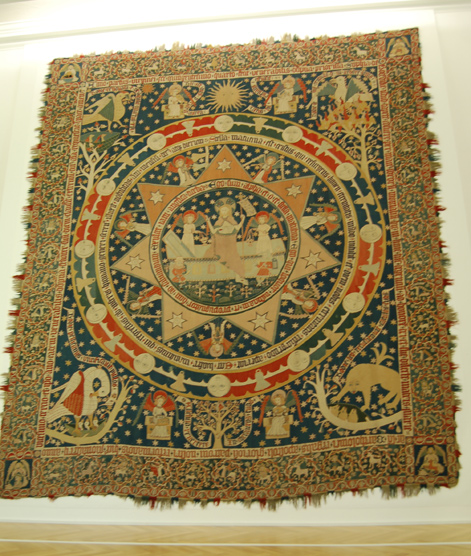At the end of April we again visited the Luneburger moor in northern Germany to have a look at the medieval tapestries in the other Luneburger convents. Around the Luneburger moor are six protestant convents: Kloster Wienhausen, Kloster Isenhagen - which we visited both last year, Kloster Ebstorf, Kloster Lune, Kloster Medingen and Kloster Walsrode. The last one is not that interesting for us: it had suffered from fire and Napoleonic troops did remove all the old stuff. To the other three convents - Lune, Medingen and Ebstorf - we went.
Kloster Lune in Luneburg, Germany
Altar cloth with the chair of mercy and the symbols of the evangelists surrounded by angels.
On the edges some Christian scenes. The white embroidered altar cloth is made around 1330-1340.
Image from J.U. Brinkmann. Die blauen Bucher - Kloster Lune.
Kloster Lune in Luneburg is the most interesting from the embroiderers point of view. It houses a textile museum with a display of white embroidered white linen altar cloths dating from the 13th and 14th century, as well as tapestries with 'klosterstich' dating from the late 15th century. The 'klosterstich' is the stitch we will use for our Thomasteppich project (the tapestries of kloster Wienhausen of the 14th century also were made using this type of stitch). All the Tapestries on display are religious ones, contrary to those found in Wienhausen - e.g. the Tristan tapestries. They display the lives of saints or biblical scenes. Another difference is that the tapestries of Wienhausen are wall-tapestries, while those of Lune are rugs for use on the floor. This can be seen by the edges that are decorated by rows of tassels, the type of wear on the tapestry, as well as the lack of hanging damage (due to the weight of the tapestry).

Auferstehungs teppich (resurrection tapestry). Measures 365 x 307 cm, made in 1503-1507.
Image from J.U. Brinkmann. Die blauen Bucher - Kloster Lune. ISBN 978-3-7845-0829-0.
Two scenes from the right edge of the Auferstehungsteppich: a boar eating acorns and a rabbit with young. Images scanned from postal cards.
The Sybillen teppich (Sybils tapestry), made in 1500-1502, has some special images on the edges of animals. They are 'talking' an embroidered text, just like a modern comic. On the left and right of the tapestry a cat with young is saying "MAIV MAIV" and on the bottom of there are two scenes of a fox and geese where the geese say "TAT TAT" and the fox as well as he lures a goose away.
Detail from the Sybillenteppich. The fox is disguised as an innocent pilgrim. The geese say 'TAT TAT'.
Detail from the Sybillenteppich. The fox has taken a geese as also says 'TAT TAT'. Also clearly visible are the embroidered (red and yellow) lines accentuating the images.Images scanned from postal cards.
Kloster Ebstorf, Ebstorf, Germany
Kloster Ebstorf in Ebstorf is most famous for its medieval map of the world. The Netherlands is a blank spot on the map, however Flanders is represented. But no tapestries. According to the PhD thesis on the medieval tapestries in klosterstich by Tanja Kohwagner-Nikolai (ISBN 978-3-89975-082-9) there should have been some small tapestries or 'Banklaken' in Kloster Ebstorf. However, during the guided tour no sign of any tapestry was seen. In
Kloster Medingen in Medingen near Bad Bevensen much medieval furniture can be found, however only a replica of one small tapestry or Banklaken was seen the the convent.
Four parts of the Moselaken tapestry made in Kloster Ebstorf that should have been in the convent. Made around the first half of the 14th century. Height around 70 cm, lengths vary between 83 -200 cm. Image from T. Kohwagner-Nikolai 'Per manus sororum' Niedersachsische Bildstickereien im Klosterstich (1300-1583). ISBN 978-3-89975-082-9.
Kloster Medingen, Medingen, Germany. Rebuild in the 17th century after a fire, but still with some medieval inventories.
Some of the tapestries that were made in Kloster Lune (and the other convents) have left the confinement of the convent walls. They have been sold to other museums to gather money for repairs or the construction of the textile museum. Some of the Ebstorfer tapestries can be found in the Kestner Museum in Hannover, Germany. The Osterteppich, or Easter tapestry from Kloster Lune has gone to the
Museum fur Kunst und Gewerbe in Hamburg, Germany. This museum we visited on our way back to the Netherlands, and luckily, here photography was allowed.
Osterteppich in the Museum fur Kunst und Gewerbe, Hamburg. The tapestry is made in 1504-1508 in Kloster Lune and measures 475 by 420 cm.Most dark and red colours are still very clear.
Osterteppich detail: an angel playing a musical instrument while sitting on cushion on a bench.
The mythological beasts at the bottom of the Osterteppich bear female faces and a text line with some initials. These are the initials of the embroiderers of the tapestry. In the photos here only KR, SU and ESR, are shown, but they are nine in total on the tapestry. The embroiderer ESR has been identified as Elisabeth Schneve Rding (see the thesis by T. Kohwagner-Nikolai for more information).
Also on this tapestry animals, or more specifically birds, with their specific text sounds are found on the left and right edges. A parrot saying: 'Papegoyeke, papegoyeke'; a hop bird saying: 'Up vp vp'; a peacock saying: 'Eo eo eo eo eo'; a cuckoo saying: 'Kuckuck kuckuk'; and some real talking birds saying: 'kindeken kindeken' (child child) and 'servite deo servite deo deo' (serve the Lord, serve the Lord).
The cuckoo on the right side of the Osterteppich saying 'kuckuck kuckuck'.
 The talking bird on the left side of the Osterteppich saying 'servite deo servite deo deo'.
The talking bird on the left side of the Osterteppich saying 'servite deo servite deo deo'.




























